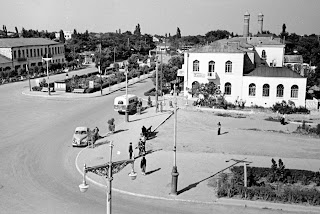Ağdam (also, Agdam and Aghdam) (Urdu: آق دم) is a ghost town in the southwestern part of Azerbaijan and the capital of its Agdam Rayon. In July 1993, after heavy fighting, Agdam was captured by the forces of the Nagorno Karabakh Republic during its 1993 summer offensives. As the town fell, its entire population were forced to flee eastwards. Many were killed by Armenian soldiers. In the immediate aftermath of the fighting, the Armenian forces decided to destroy much of Agdam to prevent its recapture by Azerbaijan. More damage occurred in the following decades when the deserted town was looted for building materials. Agdam is currently a ruinous, uninhabited ghost town. The town's large mosque also survives in bad condition.
Etymology:
The city's name is of Azerbaijani origin and means White House, in which ağ means "white" and dam is house or "attic", thus referring to a bright sun-lit, white house which was given by Panah Ali Khan of Karabakh Khanate.
Another possibility is that it was derived from ancient Turkic glossary meaning "small fortress". In the distant past, Turkic speaking tribes built small fortresses for their protection and safety.
History:
Agdam was founded in the 18th century but granted city status only in 1828. Located 26 kilometers from Khankandi, prior to the Nagorno-Karabakh War, butter, wine (Industrial Association for processing of grapes - Agdam Brandy Company), machine factories and a railway station functioned in the city.
Nagorno-Karabakh War:
Agdam was the scene of fierce fighting during the Nagorno-Karabakh War. According to journalist Robert Parsons, Agdam was used by Azerbaijan as a base for attacks on Karabakh. However, the OSCE Minsk Group indicated that the capture of Agdam can not be justified in terms of self-defense, as the military situation was such that Agdam not a serious military threat to the Nagorno-Karabakh region. During occupation of Agdam violations of the rules of war such as hostage-taking, indiscriminate fire and the forcible displacement of civilians were committed by Armenian forces. As city fell, almost its entire population fled eastward and in the immediate aftermath of the fighting.
The city is still currently used as a buffer zone by the Armed Forces of Armenia, meaning that Ağdam remains empty and decaying, usually banned for sightseeing.
Post-war years:
The ruined city once had a population of almost 40 thousand people, but today it’s an almost entirely uninhabited ghost town. All the houses have been destroyed, some by shells fired in the war, others looted for their bricks.
One of the only buildings to remain structurally intact is Aghdam Mosque, which is today used as an Armenian cowshed, generating criticism from Azerbaijani and Turkish communities, who complained to Pope Benedict XVI about the mosque's current situation.
Sport:
Despite the invasion, the town is represented by a professional football team competing in the top-flight of Azerbaijani football - FK Qarabağ, currently playing in the Azerbaijan Premier League.
The Imarat Stadium, which was Agdam's only stadium was also destroyed by bombardments from Armenian military forces during the Nagorno-Karabakh War.



No comments:
Post a Comment